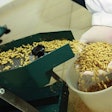The rise of the Internet has created a new business atmosphere, one where businesses are playing a constant game of catch-up, with consumer trends changing as soon as industries grow comfortable with them. In response to this rapidly changing pace, the feed and grain industry is starting to implement newer, more efficient technology. In the last decade, facility automation has gone from cutting edge to the norm, tablets and smartphones have begun their integration into facility operations, and webbased accessibility is becoming more comprehensive and available. Every company is looking for more ways to use technology to improve efficiency, but what is often overlooked is the potential for technology to connect manufacturers to the consumers of their products.
That’s why Feed & Grain partnered with the American Feed Industry Association (AFIA) and AgGateway to bestow the annual IT Innovation Award, to highlight how others are adopting technology in the grain storage and feed manufacturing industries in original ways. The 2013 runner-up is Kentucky Equine Research for its Web-based feed wizard MicroSteed™. This accessible program has 25 years of research hidden behind its easy-to-understand user interface that allows end users the ability to find out what feed will best supplement an individual horse’s needs based on its age, breed, weight and activity level, combined with its forage program.
Bridging the gap
Kentucky Equine Research (KER) is a research-based company that focuses on providing practical, real-world solutions to equine feed manufacturers. Their founder and president, Joe D. Pagan, Ph.D., has always felt that there is a lack of information available when it comes to feed nutrition.
“When I left graduate school, I entered the feed industry, and when I got there I realized there was a big gap between what was going on in academia and what was going on in the industry. So we created Kentucky Equine Research to be a bridge between the two.”
KER’s primary priority is the extensive research they perform in nutrition and exercise physiology at their research facility in Versailles, KY. Using state-of-the-art testing equipment, unavailable to many manufacturers, they evaluate how athletic horses use nutritional ingredients, vitamins and minerals, along with tests on how various feedstuffs affect performance in a horse.
KER also works with 35 horse feed manufacturers on six continents as Brand Alliances. The partnership includes giving feed manufacturers technical support to formulate existing or brand-new feeds based on the class of horse or performance level the manufacturer is targeting and the local forage. The manufacturer can make sure that not only are their customers receiving the performance they desire, but that the blend is the exact mix necessary to meet it. The wide range of nutritional needs required by horses makes it hard to calculate exactly what level of basic nutrients — protein, fats, carbohydrates, minerals and vitamins — are needed. Without proper testing, it is easy for feed manufacturers to oversupply a particular nutrient, leading to products that cost more money to produce
Behind the curtain
Although MicroSteed recently launched a new design and platform, the program itself has been around since the early 1990s in various forms. It was designed to address a problem relating the scientific data needed to properly integrate feed into the overall ration being used by the horse owner.
“One of the big things we wanted to be able to do from the very beginning was to be able to show an end user how a feed company’s product fits into the overall context of a ration,” Pagan explains.
The problem comes from how to get this important yet cumbersome data to the user in a timely, easy-to-grasp form.
“In the late 1980s, Microsoft Excel hadn’t been rolled out yet, so doing those types of ration evaluations were difficult. You were literally doing them with a calculator and a legal pad, and then when you were done you had a set of numbers that didn’t mean much to the typical horse owner,” said Pagan.
So, KER started to look at a way to provide that vast amount of information to the average horse owner — in a visually pleasing form — eventually settling on the stacked bar graph that they use today, with each bar depicting the percentage of the required amount of a nutrient in the ration and individual ingredient contributions toward the total shown as colored gradients within each bar. The company selected the program Harvard Graphics, and while it made the information easier to digest, it still took half a day to evaluate a ration. They started to work toward a custom software solution to meet their needs. In the early 1990s KER developed the first MicroSteed, a 16-bit Windows-based software. MicroSteed has continued to evolve alongside the available technology, until two years ago when KER decided it was time to move it to a Web-based platform bringing us to the current iteration.
A new opportunity
When making the decision to bring MicroSteed to a Web-based platform in 2010, KER took a look at where the world was. Though the Internet was still in its infancy at KER’s founding, it was fully integrated into both personal and professional life by the time they decided to use a new platform. With the rise of smartphones and tablets, there are fewer and fewer places that are not connected to the grid, and the demand to be able to access anything from anywhere is increasing.
The MicroSteed website is simple, but comprehensive. It is developed on a wizard platform, which was selected because it is easy to use, and can convey the vast amount of information sitting right behind the framework. The age of trying to fit as much information on the screen as possible is past. The user inserts information into easy-to-understand fields for each of the 12 categories such as age, body weight, breed, life stage, activity level and amount of time at pasture. Each category comes with a magnifying glass that gives more detail on the category in question, giving the users more information about the choices, information on how to gather the needed data and how the data will be used. The wizard will then give the user a selection of feeds that will meet their horse’s nutrition needs along with a link to the manufacturer’s page, with more information about the blend. The feed selection page also offers users the chance to email the manufacturer with questions about the blends offered and any questions they have about the entire process. The feed selection page is followed by the completed ration page, featuring both the stacked bar graph and an acceptable ranges graph explaining the nutrition the horse is receiving based on the overall ration.
This program is targeted toward end users, and in the world of equine ownership, that range includes everything from highend racehorses to the family horse. Not every user will be concerned about every category MicroSteed gives an option for, but they don’t need to be. Any of the categories, other than classification, can be left blank, leaving the tool usable to all levels of users. And though there are 25 years of research being used to formulate these recommendations, the user never sees it, nor the huge amount of possibilities that exist within the wizard.
“Because all of these variables come into play, there are infinite possible combinations that affect nutrient requirements,” explains Pagan. “MicroSteed takes all of these into consideration and calculates nutrient requirements on the fly.”
MicroSteed has been adapted for each of KER’s Brand Alliances. Each version of the site is set up to reflect the unique factors that are important to the individual feed manufacturer and its end users. As a multinational organization, it’s not only the categories that can be changed, but also the unit of measurements, allowing a familiar experience for end users no matter where they are located.
Feed manufacturers that partner with KER give their sales team a powerful new tool when connecting to consumers. They no longer have to carry around binders full of information and give their customers a rough guess or wait for an estimate from the home office for the feed formulation that will meet the customer’s needs. Once KER has done its extensive research, most of the possible variables will already have been accounted for, and the salesperson is just a few clicks away from knowing exactly what is right for the customer. Because MicroSteed is a Web-based application, this can be done while on a sales call or in the field.
The site also adjusts for the mobile user, offering up a slightly different interface, but keeping its functionality. The idea is to be ready for the growing trend of mobile users, and to give their brand partners’ salespeople another tool in their arsenal.
“Embracing this technology will become more and more important in the future as everyone becomes more dependent on his or her smartphone in day-to-day living,” says Pagan. “KER has produced MicroSteed in versions for the computer and the smartphone so that its Brand Alliance partners can communicate with horse owners at home and in the barn aisle.”
Kentucky Equine Research’s MicroSteed is an example of how the feed industry can use technology to reach out and provide for its consumers. No matter what business, the first step in gaining customer loyalty is offering them an easy, hassle-free buying experience. MicroSteed allows users to browse at their leisure at a wide variety of feed products selected for them in the comfort of their own home, giving the confidence that what they select is right for them.
.jpg?auto=format%2Ccompress&crop=faces&fit=crop&h=48&q=70&w=48)


















